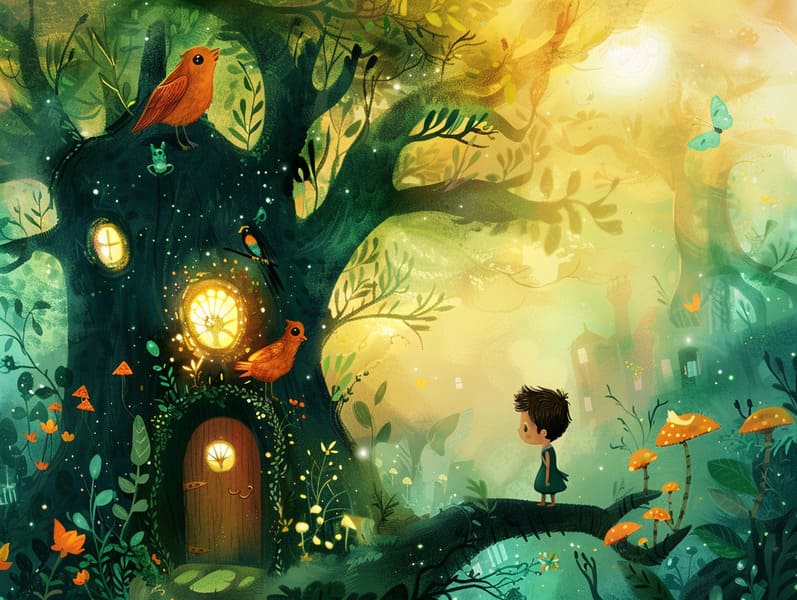
Traditional fairy tales have ancient roots. These narratives have been spoken from one generation to the next centuries before they were ever transcribed. They arose from a variety of societies, including Western traditions. They were initially told among older generations, often carrying themes and messages mirroring the societal norms and beliefs of the time.
The Brothers Grimm, Jacob and Wilhelm Grimm, were among the first to assemble many of these beloved narratives. Their volume, "Grimm's Fables," included narratives like "Cinderella," "Little Brother and Little Sister," and "The True Story of Snow White," which have since become cornerstones in the world of classic fairy tales. Similarly, Hans Christian Andersen's magical stories, such as "The Sea Maid," and "The Duckling that Could," have captivated hearts worldwide, solidifying their place in the pantheon of timeless fairy tales.
Despite being ancient, classic fairy tales remain as pertinent as ever, especially as kids' bedtime tales. These magical stories are now available in various formats, including artistically illustrated books, fantastical animations, and online storybooks.
Their continued relevance can be attributed to several fascinating points:
Valuable Lessons: Traditional fairy tales often share important moral lessons. Stories like "The Wolf and the Liar" teach the virtue of truthfulness, while "The Tortoise and the Hare" underline the merits of persistence and humility. These tales offer young readers clear distinctions between ethical and unethical, helping to shape their moral compass in a soft yet impactful way.
Compassion and Knowledge: Timeless fairy tales frequently showcase individuals facing challenges and struggles, motivating listeners to relate with their struggles and boost their triumphs. For instance, "Beauty and the Beast" demonstrates the importance of valuing inner qualities to realize the true character of a character, nurturing understanding and understanding.
Cultural Understanding: Many old fairy tales are deeply ingrained in the cultural contexts from which they bloomed. Learning from these narratives can provide fascinating glimpses into different cultures, enhancing a sense of cultural awareness and comprehension.
Fantasy and Innovation: The mythical elements in fairy tales—magical beings—revitalize children’s dreaming abilities. These stories take readers to magical realms, stimulating innovative dreams and a sense of curiosity that remains a lifetime.
Traditional fairy tales are not only spellbinding but also illuminating. They function as captivating tools in enhancing various mental and emotional abilities in kids. When timeless fairy tales are narrated, they promote verbal development by teaching new linguistic elements and complex sentence structures. This practice also improves listening skills and attention, as little ones pay close attention, eager to get more info see what happens next.
Furthermore, examining the themes and characters of fairy tales can promote intellectual skills and thought processes. Young readers are taught to recognize patterns, forecast, and catch on to cause and effect. These conversations also promote the young communicate their thoughts and feelings, enhancing their emotional intelligence.
In today’s information age, the proliferation of digital fairy tales has made these fairy tales more acquirable than ever. Online platforms and applications provide comprehensive collections of bedtime fairy tales that can be viewed or listened through anytime, anywhere. Fairy tales recited are particularly in demand, offering an interactive method for little ones to appreciate these entrancing tales. Read-aloud books and spoken videos bring characters and settings to life, often supplemented by bewitching melodies and musical scores that augment the narrative journey.
The enduring charm of timeless fairy tales lies in their ability to modify to today's world while maintaining their fundamental ideas. Contemporary reimaginings of these fairy tales often bring in more varied characters and modern settings, making them meaningful to today’s audience. However, the fundamental themes of daring, understanding, and fair play remain unchanged, continuing to reach young listeners of all ages.
Classic fairy tales also offer a sense of warmth and familiarity. They bequeath a organized narrative with a definite beginning, middle, and end, often closing with the ending of conflicts and the triumph of rightness over wrongness. This consistency can be reassuring for children, rendering a sense of stability in an inconstant world.
Old fairy tales continue to allure and train new generations, maintaining their loveliness and meaningfulness in modern society. As kids' bedtime tales, they supply a perfect blend of magic and knowledge, furthering moral values, empathy, and creativity. The accessibility of online storybooks and the favor of fairy tales narrated warrant that these classic narratives remain reachable to new generations.
By continuing and disseminating these narratives, we continue to laud the rich tapestry of legends and cultural heritage. Whether you are accessing a richly illustrated book, delving into a virtual collection, or listening to an sound book, the attraction of children's fairy tales is always within reach. These narratives reveal of the steadfast strength of fairy tales and its ability to draw us together across centuries and lands.
Whether you are enjoying a colorful picture book, accessing a web collection, or listening through an voice book, the allure of traditional fairy tales is always within reach.
These stories teach us of the unwavering essence of tales and its ability to connect us across time and space, creating a bond that delights and instructs alike.
Comments on “The Origins of Traditional Fairy Tales and the Timeless Enchantment.”